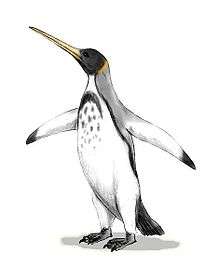Icadyptes
Icadyptes is an extinct genus of giant penguins from the Late Eocene tropics of South America.
| Icadyptes | |
|---|---|
 | |
| Icadyptes salasi | |
| Scientific classification | |
| Kingdom: | Animalia |
| Phylum: | Chordata |
| Class: | Aves |
| Order: | Sphenisciformes |
| Family: | Spheniscidae |
| Genus: | †Icadyptes |
| Species: | †I. salasi |
| Binomial name | |
| †Icadyptes salasi Clarke et al., 2007[1] | |
Etymology
The genus name is a combination of "Ica" for the Peruvian region where the type species was found and "dyptes" from the Greek word for diver. The species epithet "salasi" refers to Rodolfo Salas Gismondi, a noted Peruvian paleontologist.
Description
Standing about 1.5 metres (4.9 ft) tall, the penguin was much larger than any of its modern-day cousins, yet Icadyptes salasi is merely the third largest penguin ever described.[2] It had an exceptionally long spear-like beak resembling that of a heron. The researchers who discovered the penguins believe the long, pointed beaks to be the likely ancestral shape for all penguins.
Discovery
The fossilised remains of the penguin, which lived approximately 36 million years ago, were found in the Otuma Formation,[3] in the coastal desert of Peru by the team of North Carolina State University palaeontologist Dr. Julia Clarke, assistant professor of marine, earth and atmospheric sciences. Its well-preserved fossil skeleton was found on the southern coast of Peru together with an early Eocene species Perudyptes devriesi (comparable in size to the living King penguin), and the remains of three other previously undescribed penguin species, all of which seem to have preferred the tropics over colder latitudes. Perudyptes devriesi is named after the country, and Thomas DeVries, a Vashon Island High School science teacher[4] who has long worked in Peru.
Evolution
Icadyptes salasi and Perudyptes devriesi appear to have flourished at warmer latitudes at a time when world temperatures were at their warmest over the past 65 million years. Only a few modern-day penguins, such as the African and Galapagos penguins prefer such a balmy climate.
The discovery of the fossils has caused a re-evaluation of penguin evolution and expansion. Previously, scientists believed that penguins evolved near the poles in Antarctica and New Zealand, and moved closer to the equator around 10 million years ago. Since Icadyptes salasi lived in Peru during a period of great warmth, penguins must have adapted to warm climates around 30 million years earlier than previously believed. [5]
References
- Clarke, Julia A.; Daniel T. Ksepka; Marcelo Stucchi; Mario Urbina; Norberto Giannini; Sara Bertelli; Yanina Narváez; Clint A. Boyd (2007-06-29). "Paleogene equatorial penguins challenge the proposed relationship between penguin biogeography, body size evolution, and Cenozoic climate change". Proceedings of the National Academy of Sciences. 104 (28): 11545–50. doi:10.1073/pnas.0611099104. PMC 1913862. PMID 17601778. Retrieved 2007-06-30.
- Schmid, Randolph E. (2007-06-25). "Giant Penguins May Have Roamed Peru". Associated Press via Washington Post. Retrieved 2007-06-29.
- Icadyptes at Fossilworks.org
- "Tom Devries Class Web Page". Vashon Island School District. Archived from the original on 2010-12-01. Retrieved 2008-01-27.
- "March of the Giant Penguins: Fossils Reveal Early Penguins Reaching 5 Ft. Tall Lived Near the Equator During One of Earth's Warmest Periods". North Carolina State University. 2007-06-25. Archived from the original on 2007-07-05. Retrieved 2007-06-29.